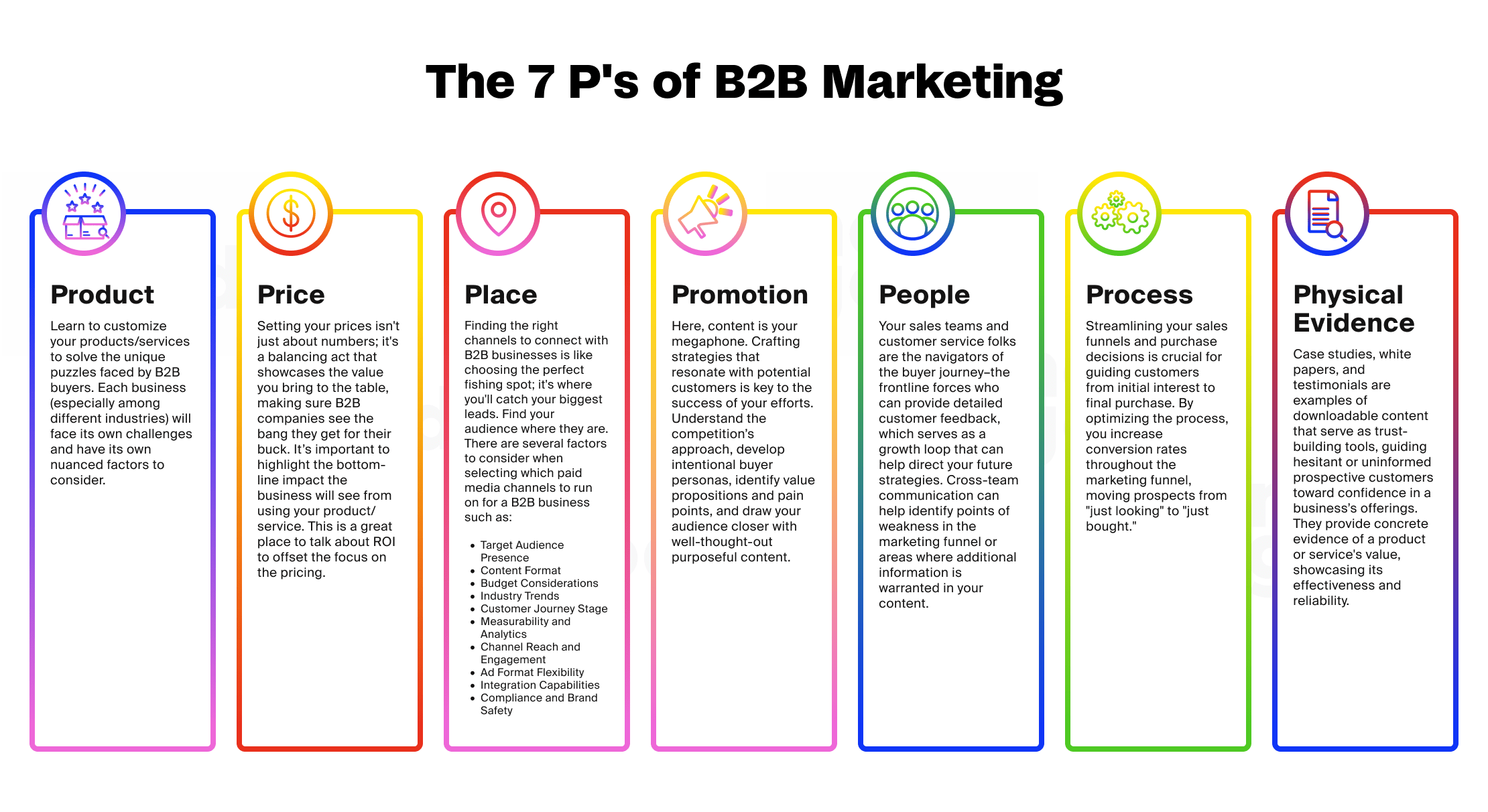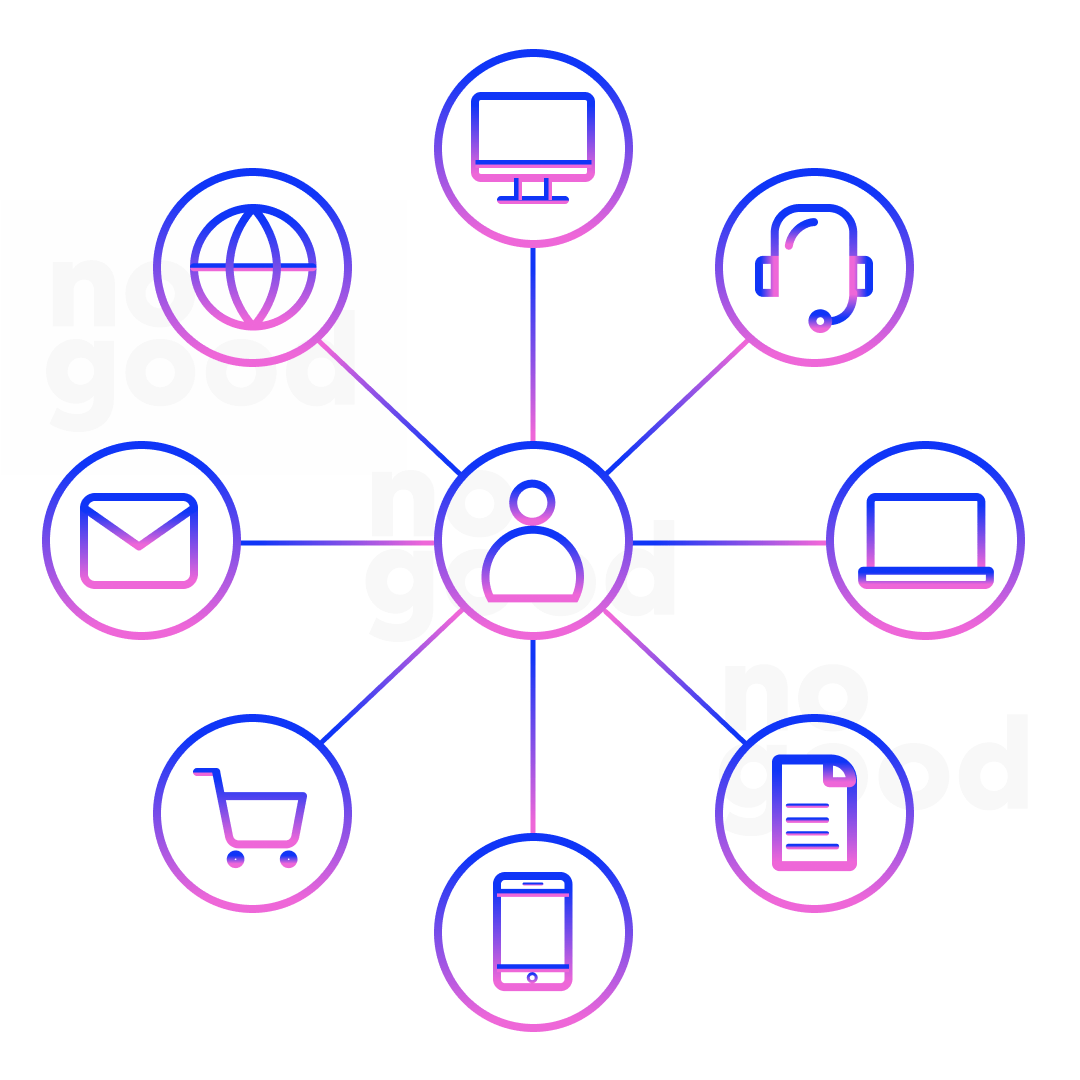What is B2B Performance Marketing?
Think of B2B performance marketing as your GPS in the world of business-to-business dealings. It’s a data-driven approach that focuses on achieving specific, measurable outcomes. Whether it’s generating leads, conversions, sales, or even awareness, every action is aimed at contributing directly to your bottom line. And in the B2B realm, where decisions are weighed heavily and made by more than one pair of hands, this approach is not just nice to have; it’s a must-have.
The beauty of B2B performance marketing lies in its ability to turn insights and learnings into actions. By leveraging channels like SEO, PPC, content marketing, and social media advertising, we’re not just shouting into empty space. We’re using experimentation to engage in meaningful conversations with potential business customers, using data to guide us every step of the way.
Now, you might wonder, “Isn’t all performance marketing the same?” Well, not quite. B2B and B2C marketing might share a stage, but they play very different roles.
B2B marketing is similar to a chess game. It’s strategic, with longer sales cycles and higher stakes. You’re dealing with multiple decision-makers, oftentimes, each with their own set of concerns and criteria. The challenge here, among navigating ever-changing stakeholders and evolving goals, is to nurture these leads through a complex journey, using targeted content to address their specific needs at each stage.
B2C marketing, on the other hand, is more like checkers. It’s faster paced and the strategies here are aimed at rapidly capturing the consumer’s attention to drive them towards an immediate conversion event like a purchase or other action.
This distinction is crucial because it helps shape our approach to performance marketing. In B2B marketing, it’s not just about making a sale; it’s about establishing trust and proving value over time.
At the end of the day, the heart of B2B performance marketing serves one purpose – increasing conversion rates. This is where we can transform potential into profit and drive tangible results for businesses.
But, how do we get there? It starts with personalization. By identifying value propositions and establishing personas, we understand our audience’s unique needs and preferences, and we can tailor our messages to resonate deeply with our targeted personas. Then, we cast our net across multiple channels, ensuring we are serving ads where our audience is speaking their language.
Content is king here, but not just any content. What works is content that is value-driven and educates and informs. Some effective examples of this type of content are downloadable PDFs or articles such as white papers, case studies, and industry insights that speak directly to the challenges our audience faces.
And, of course, we can’t forget about measuring and analyzing performance results. This is our compass, guiding us through the wilderness of marketing strategies. By continuously measuring and optimizing our efforts, we ensure that every step taken is a step closer to our goal.
The 7 P’s of B2B Marketing
To navigate the world of B2B marketing successfully, it is important to familiarize yourself with the 7 P’s of B2B marketing. These fundamental principles will help guide your strategy, ensuring that every decision and action aligns with the north star of connecting with your business audience.
- Product: Learn to customize your products/services to solve the unique puzzles faced by B2B buyers. Each business (especially among different industries) will face its own challenges and have its own nuanced factors to consider.
- Price: Setting your prices isn’t just about numbers; it’s a balancing act that showcases the value you bring to the table, making sure B2B companies see the bang they get for their buck. It’s important to highlight the bottom-line impact the business will see from using your product/service. This is a great place to talk about ROI to offset the focus on the pricing.
- Place: Finding the right channels to connect with B2B businesses is like choosing the perfect fishing spot; it’s where you’ll catch your biggest leads. Find your audience where they are. There are several factors to consider when selecting which paid media channels to run on for a B2B business, such as:
- Target Audience Presence: Identify where your B2B audience spends their time online. LinkedIn, for example, is optimal for reaching professional audiences
- Content Format Compatibility: Choose channels that best support your content format, whether it’s video, text, infographics, or webinars
- Budget Considerations: Evaluate the cost-effectiveness of each channel. Some platforms may offer a better ROI for B2B campaigns
- Industry Trends: Stay abreast of where competitors and industry leaders are most active, which can indicate effective channels for your sector
- Customer Journey Stage: Select channels that align with the stages of your customer journey, from awareness through decision-making
- Measurability and Analytics: Opt for platforms with robust analytics to measure campaign performance and optimize for better results
- Channel Reach and Engagement: Assess the reach and level of engagement potential customers have with the platform
- Ad Format Flexibility: Consider channels that offer a range of ad formats to creatively showcase your value propositions
- Integration Capabilities: Look for platforms that can integrate seamlessly with your other marketing tools and CRM system
- Compliance and Brand Safety: Ensure the channel aligns with your brand values and complies with industry regulations
- Promotion: Here, content is your megaphone. Crafting strategies that resonate with potential customers is key to the success of your efforts. Understand the competition’s approach, develop intentional buyer personas, identify value propositions and pain points, and draw your audience closer with well-thought-out, purposeful content.
- People: Your sales teams and customer service folks are the navigators of the buyer journey–the frontline forces who can provide detailed customer feedback, which serves as a growth loop that can help direct your future strategies. Cross-team communication can help identify points of weakness in the marketing funnel or areas where additional information is warranted in your content.
- Process: Streamlining your sales funnels and purchase decisions is crucial for guiding customers from initial interest to final purchase. By optimizing the process, you increase conversion rates throughout the marketing funnel, moving prospects from “just looking” to “just bought.”
- Physical Evidence: Case studies, white papers, and testimonials are examples of downloadable content that serve as trust-building tools, guiding hesitant or uninformed prospective customers toward confidence in a business’s offerings. They provide concrete evidence of a product or service’s value, showcasing its effectiveness and reliability.
Each of these elements plays a pivotal role in the grand scheme of B2B performance marketing and are all individual levers to experiment with throughout the growth process. Experimentation with each one of these levers can lead to faster learnings that will ultimately drive growth for your business.

Crafting a B2B Performance Marketing Strategy
Creating a B2B marketing strategy that resonates with your audience and drives results requires a deep understanding of the landscape and the unique challenges of the B2B buying journey. Unlike the typically shorter path in D2C, the B2B journey is longer and more complex, necessitating a different approach to push prospects along the buying journey. This means providing a lot more information about how the decision to purchase will drive business results that contribute to the bottom line.
Identifying your target audience and understanding the buyer journey are foundational steps. It involves delving into who your ideal customers are, the challenges they face, and how they make decisions. This understanding informs every piece of content you create and every interaction you have with your audience. Many businesses see success with account-based marketing (ABM) and use a suite of tools to bolster their targeting approaches. Here’s a short list of tools if you’re interested in taking an ABM approach:
- LinkedIn Ads: LinkedIn offers powerful targeting options for B2B marketers, allowing you to target ads based on company size, industry, job title, seniority, and more. With LinkedIn’s extensive professional network, you can reach decision-makers and influencers within your target accounts effectively.
- Demandbase: Demandbase is a comprehensive ABM platform that provides account-level targeting capabilities. It uses proprietary technology to identify and target specific companies based on firmographic data, website engagement, and intent signals, enabling personalized campaigns tailored to each target account.
- RollWorks: RollWorks is an account-based platform that combines account-based advertising with account-based data and sales automation to identify and engage target accounts across multiple channels, including display, social, email, and web.
- Terminus: Terminus is a leading ABM platform specializing in targeting and engaging high-value accounts. It offers a suite of targeting tools, including account-based advertising, email marketing, and web personalization to reach key decision-makers and influencers within target accounts.
- 6sense: 6sense is an AI-powered ABM platform that uses predictive analytics to identify and prioritize target accounts based on their likelihood to buy. It provides insights into account behavior and intent signals, enabling you to deliver personalized experiences and targeted campaigns to the most promising prospects.
Another key factor in a successful B2B Performance Marketing approach is developing a content strategy that addresses the needs and pain points of B2B buyers. This is about crafting a narrative that directly addresses your audience’s needs and challenges. Whether through whitepapers, videos, or infographics, your content should educate, engage, and inspire your audience throughout the buyer journey.
Selecting the Right Performance Marketing Channels is crucial. This involves choosing channels where your audience is most receptive, such as SEO, email marketing, social media, and native advertising. Each channel serves a different purpose, from visibility to engagement, and should be prioritized based on your goals and resources.
In essence, crafting a B2B marketing strategy is about connecting the dots between understanding your audience and delivering the content they need to nurture them throughout the buying journey while utilizing the channels where they’re most likely to engage.

It’s a deliberate process that requires insight, creativity, and precision. By focusing on these core elements, you lay the groundwork for a strategy that not only reaches your target audience but also drives them toward action, ultimately delivering the results your business seeks.
Performance Marketing Tactics for B2B
SEO Strategies Tailored to Organic Search and B2B Keywords: B2B buyers will often conduct extensive research before making purchasing decisions. To ensure your brand is visible during this research phase, your SEO strategy should focus on optimizing your website and content for relevant B2B keywords. This involves conducting thorough keyword research to identify the terms and phrases your target audience is using, and then strategically integrating them into your website copy, blog posts, and other content (whitepapers, case studies, etc.). Additionally, optimizing technical aspects of your website, such as site speed and mobile responsiveness, can further enhance your search visibility and improve user experience.
Looking for a full list of SEO optimization strategies?
We’ve already discussed the importance of content marketing as a powerful tool for providing value and building trust throughout the buyer journey. In addition to the downloadable content listed above, another great way for businesses to provide informative content is to create and publish regular blog posts and articles that address common pain points and demonstrate your expertise.
These types of content not only educate your audience while encouraging them to come back for more, but this content will also position your business as a thought leader in the space.
As with all performance marketing strategies, it is pertinent to ensure that your data collection is top of mind. Conversion tracking should be set up across all channels and pages, and in the cookieless world we’re entering, you should be collecting zero-party data wherever possible. Here’s a great resource on how to implement a zero-party data strategy.
Lastly, building a community through social media is another tactic that can help prove thought leadership and establish your business as a trusted resource in your industry. It’s crucial to develop a social media strategy that fosters audience engagement and brand awareness. Although B2B decision-makers may not spend as much time on social media as their B2C counterparts, platforms like LinkedIn and Twitter still play a crucial role in the B2B marketing landscape.
Here, you can share content, engage with industry influencers, and participate in relevant conversations. Additionally, consider leveraging paid social advertising to target specific B2B audiences and amplify your brand’s reach. By consistently sharing valuable content and actively engaging with your audience, you can build brand awareness, establish authority in your industry, and generate leads for your business.
Measuring Success in B2B Performance Marketing

With all these efforts to build and engage an audience, it’s vital to set clear marketing goals that align with your overall business objectives and define B2B marketing KPIs so that you can measure and track what your success looks like. Whether your aim is to increase lead generation, boost brand awareness, or drive conversions, clearly defined goals provide direction and focus for your marketing efforts.
Additionally, identifying key performance indicators (KPIs) specific to B2B marketing—such as lead-to-customer conversion rate, marketing-qualified leads (MQLs), and customer lifetime value (CLV)—allows you to measure progress and gauge the success of your campaigns accurately.
Ensure that you have set up your analytics backend properly with the appropriate tools for your business. Generally speaking, Google Analytics is a powerful tool for tracking and analyzing website traffic, user behavior, and campaign performance.
By implementing tracking codes and setting up conversion goals, you can gain valuable insights into how visitors interact with your site and which marketing channels drive the most engagement and conversions. Analyzing metrics such as bounce rate, time on page, and conversion rate helps you understand buyer behavior and identify areas for optimization.
Now equipped with data from Google Analytics and other analytics platforms, you can make informed decisions about where to allocate your budget to achieve the highest return on investment (ROI). By continuously monitoring campaign performance and comparing results against your predefined KPIs, you can identify underperforming channels or tactics and reallocate resources to those that drive the greatest results.
Whether it’s scaling up investments in top-performing channels or experimenting with new strategies to improve performance, data-driven decision-making allows you to optimize your marketing spend and maximize ROI over time.
Conclusion
In summary, B2B performance marketing is a calculated journey aimed at driving conversions and value for businesses in the short and especially long term. It’s the light guiding marketers toward specific, measurable outcomes that directly contribute to the bottom line.
Understanding the 7 P’s of B2B marketing is crucial for crafting a successful strategy, as it ensures alignment with the business audience and their unique needs. Effective targeting through tools like LinkedIn Ads and 6Sense enables marketers to engage high-value target accounts effectively, driving personalized campaigns tailored to each account’s needs. Additionally, a robust content strategy that addresses the needs and pain points of B2B buyers is essential for nurturing leads throughout the buyer journey.
Finally, measuring success through clear marketing goals, carefully defined KPIs, and analytics tools like Google Analytics allows marketers to use data-driven insights to continuously optimize campaigns and maximize ROI.




